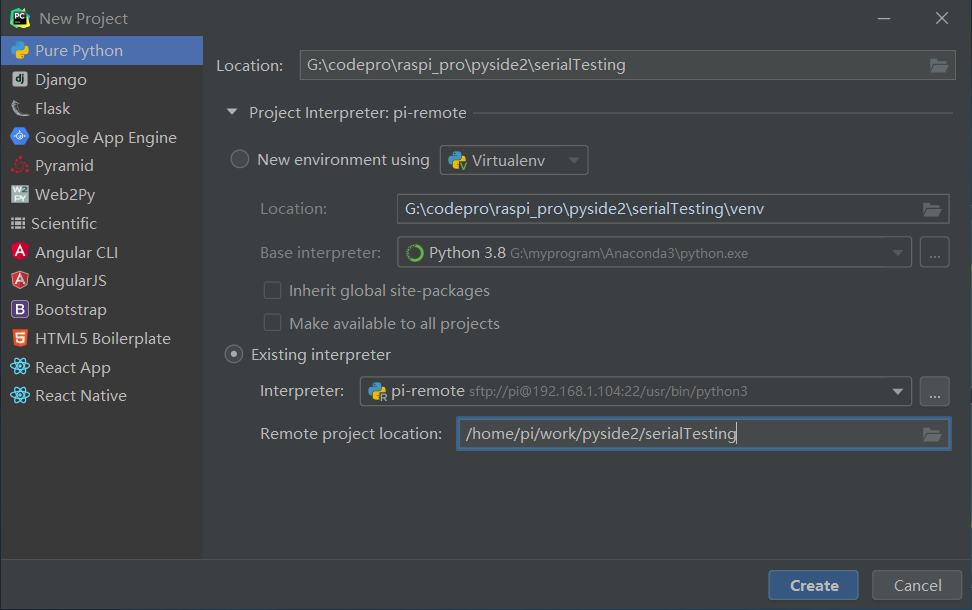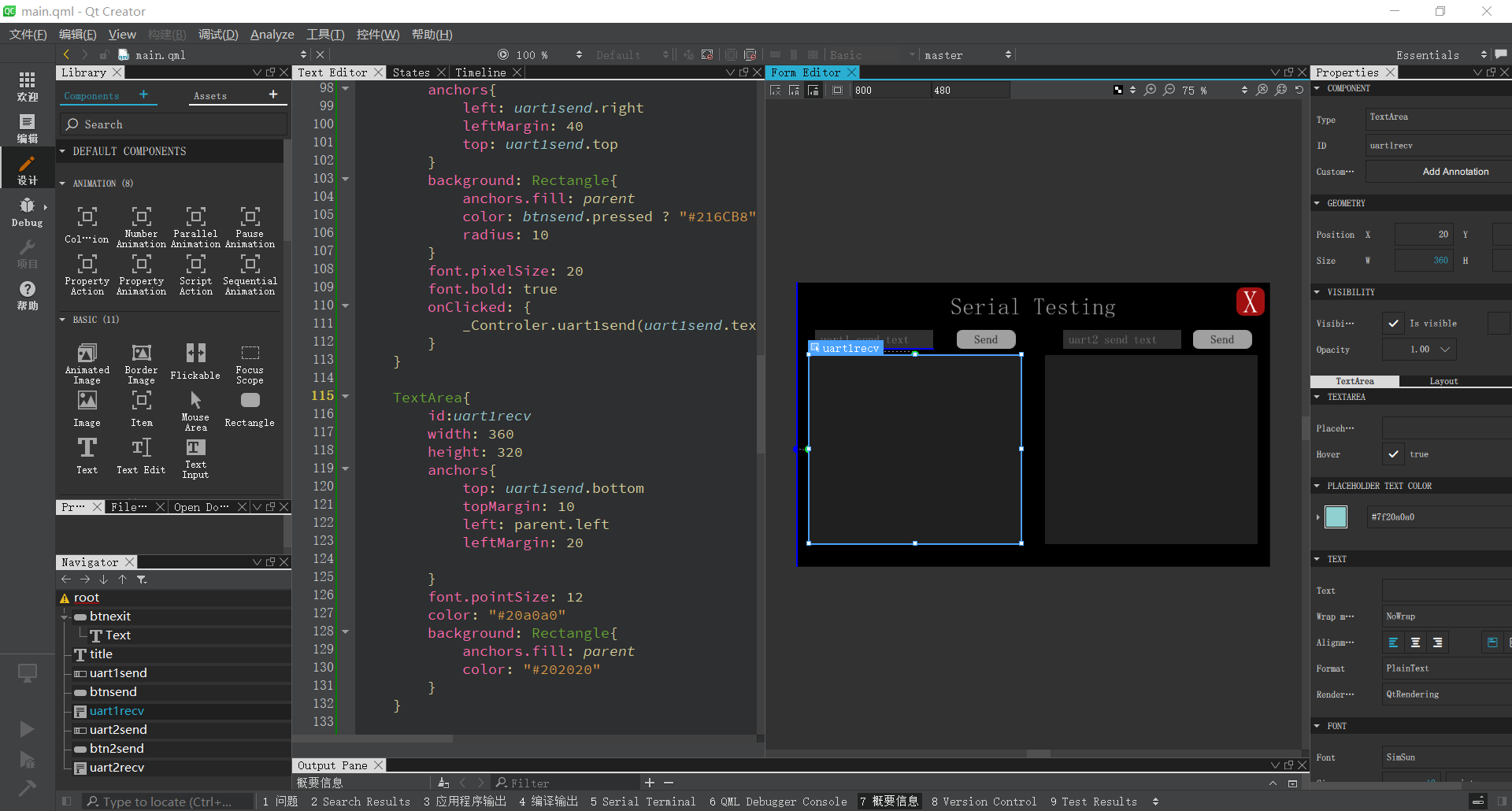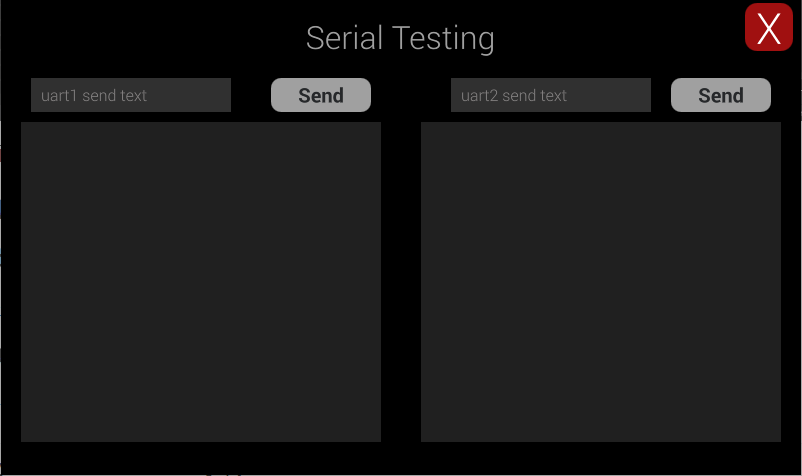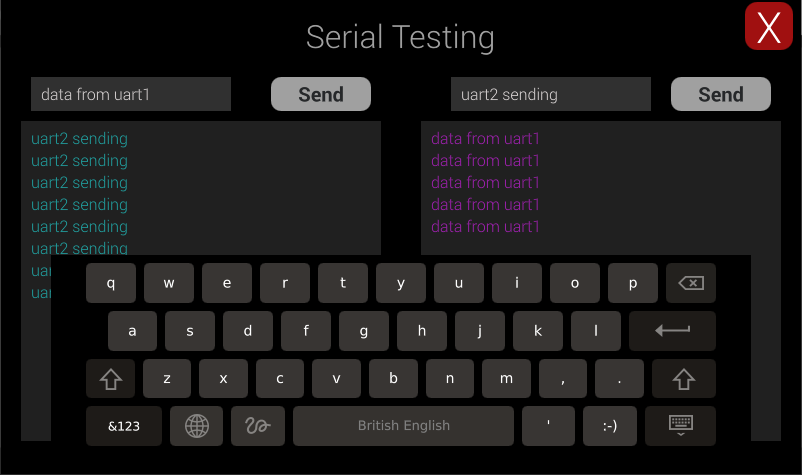介绍在树莓派上使用串口进行数据收发。开发环境依然使用之前介绍的PyCharm编写python代码和远程开发,然后使用QtCreator编写QML的GUI界面。
打开PyCharm,新建工程serialTesting,如下:

serialTesting.py 主程序如下:
import os import sys from pathlib import Path import serial import threading from PySide2 import QtCore from PySide2.QtCore import Qt, QObject, Slot from PySide2.QtQml import QQmlApplicationEngine from PySide2.QtWidgets import QApplication mserial1 = serial.Serial('/dev/ttyAMA1',115200) mserial2 = serial.Serial('/dev/ttyAMA2',115200) def Serial1Reading(): while True: while mserial1.inWaiting() > 0: s = mserial1.read(mserial1.inWaiting()) s = s.decode() if s != "": print("serial1 recv:", s) controler.uart1sig.emit(s) def Serial2Reading(): while True: while mserial2.inWaiting()>0: s = mserial2.read(mserial2.inWaiting()) s = s.decode() if s != "": print("serail2 recv:",s) controler.uart2sig.emit(s) thread1 = threading.Thread(target=Serial1Reading) thread2 = threading.Thread(target=Serial2Reading) class Controler(QObject): uart1sig = QtCore.Signal(str) uart2sig = QtCore.Signal(str) def __init__(self): super().__init__() @Slot() def exit(self): sys.exit() @Slot(str) def uart1send(self,s): print("uart1 send:",s) if mserial1.isOpen(): mserial1.write(str(s).encode()) @Slot(str) def uart2send(self,s): print("uart2 send:",s) if mserial2.isOpen(): mserial2.write(str(s).encode()) if __name__=='__main__': os.environ["QT_IM_MODULE"] = "qtvirtualkeyboard" a = QApplication(sys.argv) a.setOverrideCursor(Qt.BlankCursor) engine = QQmlApplicationEngine() controler = Controler() context = engine.rootContext() context.setContextProperty("_Controler", controler) engine.load(os.fspath(Path(__file__).resolve().parent / "ui/main.qml")) if not engine.rootObjects(): sys.exit(-1) root = engine.rootObjects()[0] controler.uart1sig.connect(root.uart1ReadyRead) controler.uart2sig.connect(root.uart2ReadyRead) thread1.daemon=True thread2.daemon=True thread1.start() thread2.start() sys.exit(a.exec_())
import QtQuick 2.11 import QtQuick.Window 2.4 import QtQuick.Controls 2.4 import QtQuick.Controls.Styles 1.4 import QtQuick.Extras 1.4 import QtGraphicalEffects 1.0 import QtQuick.VirtualKeyboard 2.1 import QtQuick.VirtualKeyboard.Settings 2.1 ApplicationWindow{ id:root width: 800 height: 480 visible: true visibility: Window.FullScreen function uart1ReadyRead(string){ // console.log("uart1 recv:",string) uart1recv.append(string) } function uart2ReadyRead(string){ // console.log("uart2 recv:",string) uart2recv.append(string) } background: Rectangle{ color: "black" anchors.fill: parent } Button{ id:btnexit background: Rectangle{ color: "#a01010" anchors.fill: parent radius:12 } width: 48 height: 48 anchors{ top: parent.top right: parent.right topMargin: 8 rightMargin: 8 } Text { text: qsTr("X") anchors.centerIn: parent font{ pointSize: 32 } color: "white" } onClicked: { _Controler.exit(); } } Text { id: title text: qsTr("Serial Testing") anchors{ top: parent.top horizontalCenter: parent.horizontalCenter topMargin: 20 } font{ pointSize: 24 } color: "#a0a0a0" } TextField { id: uart1send width: 200 font.pointSize: 12 placeholderText: qsTr("uart1 send text") anchors{ top: title.bottom left: parent.left topMargin: 20 leftMargin: 30 } color: "#DBD6D6" background: Rectangle{ anchors.fill: parent color: "#303030" } } Button{ id:btnsend text: "Send" width: 100 height: uart1send.height anchors{ left: uart1send.right leftMargin: 40 top: uart1send.top } background: Rectangle{ anchors.fill: parent color: btnsend.pressed ? "#216CB8" : "#a0a0a0" radius: 10 } font.pixelSize: 20 font.bold: true onClicked: { _Controler.uart1send(uart1send.text) } } TextArea{ id:uart1recv width: 360 height: 320 anchors{ top: uart1send.bottom topMargin: 10 left: parent.left leftMargin: 20 } font.pointSize: 12 color: "#20a0a0" background: Rectangle{ anchors.fill: parent color: "#202020" } } TextField { id: uart2send width: 200 font.pointSize: 12 placeholderText: qsTr("uart2 send text") anchors{ top: title.bottom right: btn2send.left topMargin: 20 rightMargin: 20 } color: "#DBD6D6" background: Rectangle{ anchors.fill: parent color: "#303030" } } Button{ id:btn2send text: "Send" width: 100 height: uart2send.height anchors{ right: parent.right rightMargin: 30 leftMargin: 40 top: uart1send.top } background: Rectangle{ anchors.fill: parent color: btn2send.pressed ? "#216CB8" : "#a0a0a0" radius: 10 } font.pixelSize: 20 font.bold: true onClicked: { _Controler.uart2send(uart2send.text) } } TextArea{ id:uart2recv width: 360 height: 320 anchors{ top: btn2send.bottom topMargin: 10 right: parent.right rightMargin: 20 } font.pointSize: 12 color: "#a020b0" background: Rectangle{ anchors.fill: parent color: "#202020" } } InputPanel { id: inputPanel z: 99 x: 50 y: parent.height width: parent.width-100 states: State { name: "visible" when: inputPanel.active PropertyChanges { target: inputPanel y: parent.height - inputPanel.height } } transitions: Transition { from: "" to: "visible" reversible: true ParallelAnimation { NumberAnimation { properties: "y" duration: 250 easing.type: Easing.InQuart } } } } } /*##^## Designer { D{i:0;formeditorZoom:0.75;height:480;width:800} } ##^##*/
界面完成后如下图:

在工程上右键将这个项目文件上传到树莓派中。
上传后,在树莓派对应文件夹中,执行如下命令执行程序:
python3 serialTesting.py
执行后可以看到显示如下:

然后可以在输入框中分别输入数据,然后点击“Send”发送,这样就可以测试串口1和串口2间数据的发送和接收:

版权声明:本文为博主原创文章,转载请声明。
